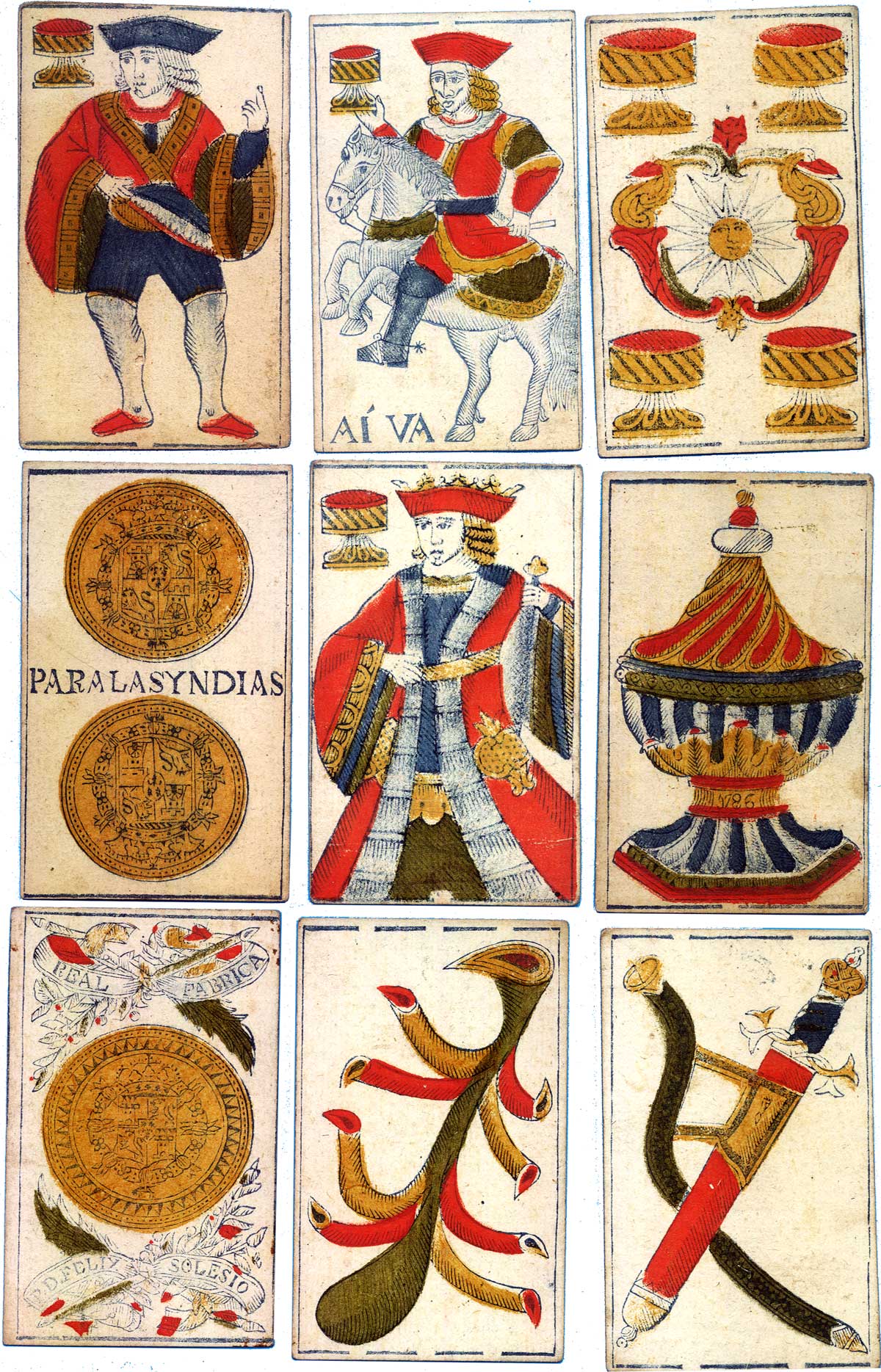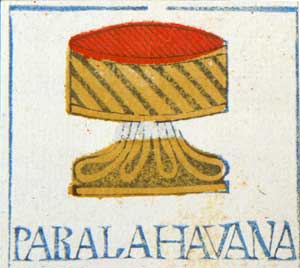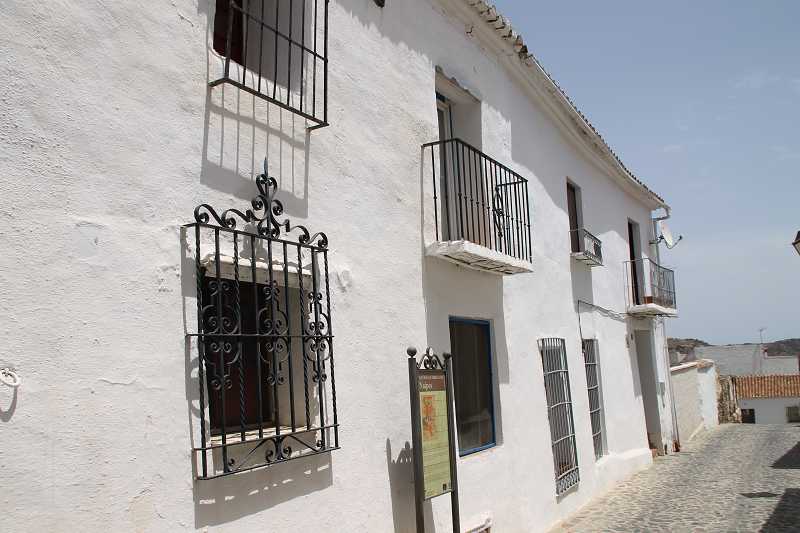Real Fábrica de Macharaviaya
This is the official Spanish National pattern of the 18th century. Design and production was controlled from Madrid as a source of national or regional revenue. The factory was located in the town of Macharaviaya, in the province of Málaga.
Real Fábrica de Macharaviaya (Málaga)
Félix Solesio

Revenues from the sales of playing cards in Central and South America had been a state monopoly since 1552, in the reign of Felipe II, who had issued a decree setting out the terms by which it was to be regulated. Packs were to be sold in paper wrappers tied with string and officially stamped. Officers were appointed to be in charge of ensuring the business was run correctly. To begin with cards destined for the Americas were manufactured solely in Mexico but due to irregular production as well as illegal imports (probably Italian) new orders were given that they should be produced in Spain.
The Real Fábrica de Madrid had been in existence since at least 1755, but in 1776 a Royal Letters Patent was issued authorising Don Félix Solesio to establish the Real Fábrica de Macharaviaya to supply playing cards to the Americas and particularly to Mexico - “Para las Indias”. The new factory was quickly built and was of benefit to the local community in terms of employment opportunities, urban development and cultural enrichment. It is recorded that in September 1777 15,000 decks produced in Macharaviaya were shipped to Mexico. Solesio was a distinguished name in the playing card industry, and as it happens, Félix Solesio's brother Lorenzo had been appointed master craftsman in the Portuguese Real Fábrica de Cartas de Jogar in 1769.



Above: an odd ace of coins having the arms of Spain on the suit-mark, above and below which are scrolls bearing poorly spelled inscriptions: 'Real Fabrica Macharaviaya por D. Felix Solesio e hijos.' © The Trustees of the British Museum
Above: cards from a pack by Don Félix Solesio destined for Mexico or South America, dated 1786 on the Ace of Cups. The two of Coins has the legend “Para las Indias”; in other examples this might be “Para Caracas” or “Para La Havana” showing that the packs were destined for Spanish colonies in Central (‘West Indies’) or South America. This is the official Spanish National pattern of the 18th century. Design and production was controlled from Madrid as a source of national or regional revenue. The factory was located in the town of Macharaviaya, in the province of Málaga►

Above: the former playing card factory at Macharaviaya. Photo credit: Marilo Marb.

Above: the former playing card factory at Macharaviaya. Photo credit: © 2017 Diputación de Málaga.
More Examples

Above: Spanish National pattern, Félix Solesio, Real Fábrica de Macharaviaya, 1809. Taken from: “Pruebas de naipes de la Real Fábrica de Macharaviaya (Málaga), para el tipo superfino”, Archivo General de Indias, MP-INGENIOS,210►
The date of closure of the Macharaviaya factory is reckoned to be 1815 [See here].
Several derivatives of this design have survived in various parts of the world, such as French ‘Aluette’ cards, ‘Parisian’ Spanish pattern (used in Uruguay) and cards used in North Africa. See also: Phelippe Ayet • Baraja Morisca • Seville 17th Century • Spanish National Pattern • Navarra 17th Century • Pedro Bosio and ‘Money Bag’ pattern • Portuguese Playing Cards • Rotxotxo Workshop Inventory • Joan Barbot • Gandarillas • Naipes Artiguistas
REFERENCES
Ferro Torrelles, Víctor: “Real Cédula aprobando el establecimiento de la Fábrica de Naipes de Macharaviaya” in La Sota Nº 16, Asescoin, Madrid, March 1997, pp.67-75
Pérez González, Alberto: “A Todos Alumbra”, facsimile of Baraja Carlos IV, Punto Verde, Benalmádena, 2006. See more →

By Simon Wintle
Member since February 01, 1996
I am the founder of The World of Playing Cards (est. 1996), a website dedicated to the history, artistry and cultural significance of playing cards and tarot. Over the years I have researched various areas of the subject, acquired and traded collections and contributed as a committee member of the IPCS and graphics editor of The Playing-Card journal. Having lived in Chile, England, Wales, and now Spain, these experiences have shaped my work and passion for playing cards. Amongst my achievements is producing a limited-edition replica of a 17th-century English pack using woodblocks and stencils—a labour of love. Today, the World of Playing Cards is a global collaborative project, with my son Adam serving as the technical driving force behind its development. His innovative efforts have helped shape the site into the thriving hub it is today. You are warmly invited to become a contributor and share your enthusiasm.
Related Articles

French Revolutionary cards by Pinaut
Seven cards from a French Revolutionary pack by Pinaut featuring characters from classical antiquity...

Tarot de las Coscojas
Historical playing card design, tarot symbolism and an almost psychedelic medieval surrealism.

Tarot de Valverde de la Vera
A series of 24 surrealist engravings by Mexican artist Claudio Favier in which archetypal Tarot alle...

Visite Mexico
Promoting Mexican tourism with 54 different photographs in full colour.

Baraja de Juan Martín Zamorano
Deck inspired by El Pendón de los Zamorano, a military pennant dating from 1501, published by Priego...

Heráldica Castanyer No. 16
Strange variant of international pattern cards for poker or bridge.

Fantasy Spanish-suited deck
Fantasy Spanish-suited deck by Bertschinger y Codina, Barcelona.

Bertschinger y Codina - Cartes Françaises
French ‘Paris’ pattern made by Bertschinger y Codina, Barcelona, c.1850.

Braulio Fournier
Baraja Nº 1 produced by Braulio Fournier, Burgos, c.1868.

Pirritx eta Porrotx
Happy Families card game from the Spanish Basque Country.

Naipe Vizcaino
‘Naipe Vizcaino’ designed by Javier Urkiri and published by Industrias Gráficas Castuera and the Caj...

Baraja Turística del País Vasco
Basque poker deck of 55 cards published by Fournier with scenic views of the Basque Country.

Catalan pattern by B.P Grimaud
Standard Spanish Catalan pattern deck made in Paris by B.P Grimaud.

Baraja Vasca
Spanish Basque Country deck with original drawings by María Isabel Ibañez de Sendadiano.

Baraja Cultura Española
ASESCOIN pack for 2022 designed by M.A. Corella featuring famous Spaniards and notable buildings.

Laurenzo Propagine
Spanish-suited cards made in Italy by Laurenzo Propagine.
Most Popular
Our top articles from the past 28 days

